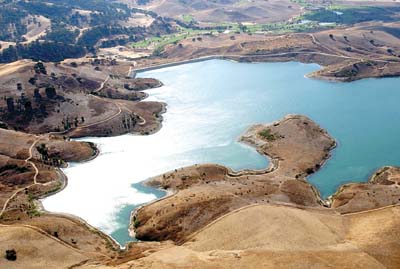
San Justo Reservoir remains closed indefinitely as various state
and federal agencies form a plan to lower the lever of water and
treat it with potash
– or potassium chloride – to eradicate invasive zebra mussels
found there earlier this year. The treatment goal of
”
late summer 2009
”
means local farmers can start planning for lacking output from
the reservoir around that time.
HOLLISTER
San Justo Reservoir remains closed indefinitely as various state and federal agencies form a plan to lower the lever of water and treat it with potash – or potassium chloride – to eradicate invasive zebra mussels found there earlier this year. The treatment goal of “late summer 2009” means local farmers can start planning for lacking output from the reservoir during that time, said Michael Jackson of the federal Bureau of Reclamation.
“It will be lowered, and that will mean less water – not lowering the reservoir would create additional challenges in terms of treatment and viability of success in the abatement of the zebra mussel,” Jackson said.
Zebra mussels are invasive shellfish that can clog water pumps and pipes and potentially cause major disruptions throughout the region and potentially the state, as San Justo is connected to the Central Valley water system. Experts have concluded the species hasn’t spread outside the local reservoir and part of their focus at San Justo – since it was the first zebra mussel discovery in California – has been to learn how the species responds to warmer waters to prevent further infestation here.
The California Department of Fish and Game initially confirmed Jan. 15 that San Justo Reservoir had been the first ever California water body infested by the zebra mussel. Officials zeroed in on potash for treatment because it is viewed as the least toxic alternative to rid the mussel species. Jackson noted how potash was used successfully to eradicate zebra mussels in Virginia at a quarry named Millbrook.
The project description, on which officials are working, is the “critical piece” toward starting the treatment’s environmental review, said San Benito County Water District Manager Jeff Bettanio.
“Because San Justo is a federal facility, we have to put the review through both NEPA (National Environmental Policy Act) and CEQA (California Environmental Quality Act)” said Bettanio, noting that the local water district is involved with Bureau of Reclamation on the project.
If the process sounds complicated, that’s because it is, said Alexia Retallack, a Fish and Game spokeswoman.
“There is a permit process, and water models being created by hydrological engineers, and during all of this we have been doing a tremendous amount of research,” said Retallack.
Since this is the first infestation this far west, she said it’s important to understand how these shellfish respond to warmer waters.
“A lot goes on here that does not go in the east,” added the spokeswoman. “Back there, the mussels spawn twice a year. But in these warm, nutrient rich waters, we are seeing up to seven times a year.”
For an expanded version of this story and a separate story on the area’s overall water outlook, see Friday’s Free Lance.









